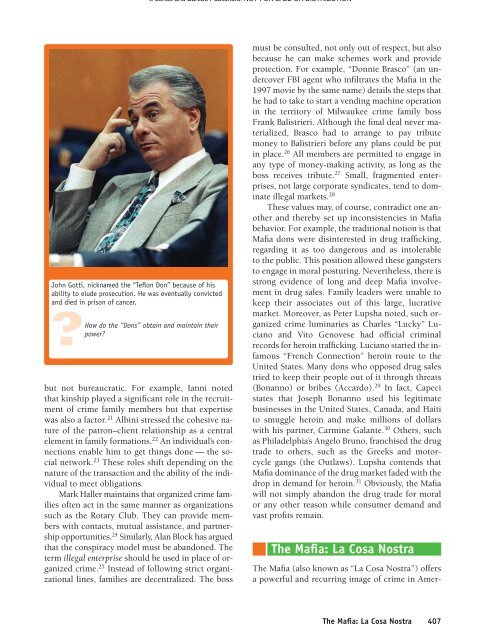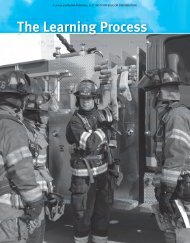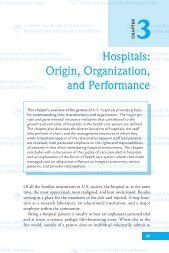CHAPTER - Jones & Bartlett Learning
CHAPTER - Jones & Bartlett Learning
CHAPTER - Jones & Bartlett Learning
Create successful ePaper yourself
Turn your PDF publications into a flip-book with our unique Google optimized e-Paper software.
30017_CH15_398_431_r7.qxp 4/7/06 3:13 PM Page 407<br />
© <strong>Jones</strong> and <strong>Bartlett</strong> Publishers. NOT FOR SALE OR DISTRIBUTION<br />
John Gotti, nicknamed the “Teflon Don” because of his<br />
ability to elude prosecution. He was eventually convicted<br />
and died in prison of cancer.<br />
?How do the “Dons” obtain and maintain their<br />
power?<br />
but not bureaucratic. For example, Ianni noted<br />
that kinship played a significant role in the recruitment<br />
of crime family members but that expertise<br />
was also a factor. 21 Albini stressed the cohesive nature<br />
of the patron–client relationship as a central<br />
element in family formations. 22 An individual’s connections<br />
enable him to get things done — the social<br />
network. 23 These roles shift depending on the<br />
nature of the transaction and the ability of the individual<br />
to meet obligations.<br />
Mark Haller maintains that organized crime families<br />
often act in the same manner as organizations<br />
such as the Rotary Club. They can provide members<br />
with contacts, mutual assistance, and partnership<br />
opportunities. 24 Similarly, Alan Block has argued<br />
that the conspiracy model must be abandoned. The<br />
term illegal enterprise should be used in place of organized<br />
crime. 25 Instead of following strict organizational<br />
lines, families are decentralized. The boss<br />
must be consulted, not only out of respect, but also<br />
because he can make schemes work and provide<br />
protection. For example, “Donnie Brasco” (an undercover<br />
FBI agent who infiltrates the Mafia in the<br />
1997 movie by the same name) details the steps that<br />
he had to take to start a vending machine operation<br />
in the territory of Milwaukee crime family boss<br />
Frank Balistrieri. Although the final deal never materialized,<br />
Brasco had to arrange to pay tribute<br />
money to Balistrieri before any plans could be put<br />
in place. 26 All members are permitted to engage in<br />
any type of money-making activity, as long as the<br />
boss receives tribute. 27 Small, fragmented enterprises,<br />
not large corporate syndicates, tend to dominate<br />
illegal markets. 28<br />
These values may, of course, contradict one another<br />
and thereby set up inconsistencies in Mafia<br />
behavior. For example, the traditional notion is that<br />
Mafia dons were disinterested in drug trafficking,<br />
regarding it as too dangerous and as intolerable<br />
to the public. This position allowed these gangsters<br />
to engage in moral posturing. Nevertheless, there is<br />
strong evidence of long and deep Mafia involvement<br />
in drug sales. Family leaders were unable to<br />
keep their associates out of this large, lucrative<br />
market. Moreover, as Peter Lupsha noted, such organized<br />
crime luminaries as Charles “Lucky” Luciano<br />
and Vito Genovese had official criminal<br />
records for heroin trafficking. Luciano started the infamous<br />
“French Connection” heroin route to the<br />
United States. Many dons who opposed drug sales<br />
tried to keep their people out of it through threats<br />
(Bonanno) or bribes (Accardo). 29 In fact, Capeci<br />
states that Joseph Bonanno used his legitimate<br />
businesses in the United States, Canada, and Haiti<br />
to smuggle heroin and make millions of dollars<br />
with his partner, Carmine Galante. 30 Others, such<br />
as Philadelphia’s Angelo Bruno, franchised the drug<br />
trade to others, such as the Greeks and motorcycle<br />
gangs (the Outlaws). Lupsha contends that<br />
Mafia dominance of the drug market faded with the<br />
drop in demand for heroin. 31 Obviously, the Mafia<br />
will not simply abandon the drug trade for moral<br />
or any other reason while consumer demand and<br />
vast profits remain.<br />
The Mafia: La Cosa Nostra<br />
The Mafia (also known as “La Cosa Nostra”) offers<br />
a powerful and recurring image of crime in Amer-<br />
1<br />
2<br />
3<br />
4<br />
5<br />
6<br />
7<br />
8<br />
9<br />
10<br />
11<br />
12<br />
13<br />
14<br />
15<br />
16<br />
17<br />
18<br />
19<br />
20<br />
21<br />
22<br />
23<br />
24<br />
25<br />
26<br />
27<br />
28<br />
29<br />
30<br />
31<br />
32<br />
33<br />
34<br />
35<br />
36<br />
37<br />
38<br />
39<br />
40<br />
41<br />
42<br />
43<br />
44<br />
45<br />
46<br />
47<br />
48<br />
49<br />
50<br />
51<br />
52<br />
The Mafia: La Cosa Nostra 407<br />
1st pass Pages

















